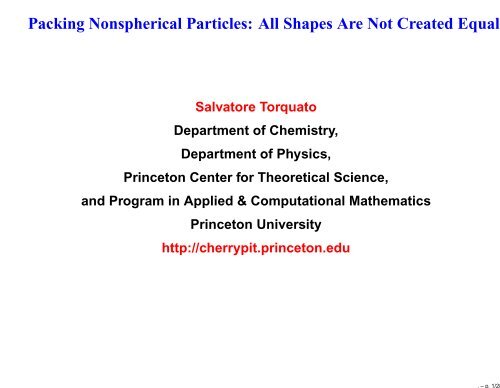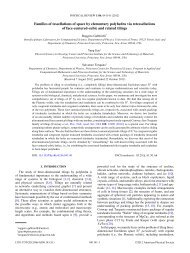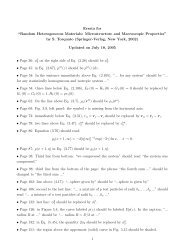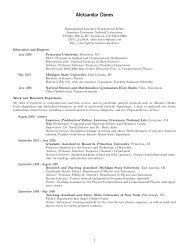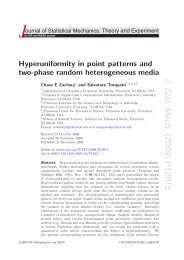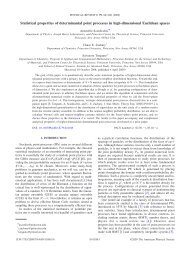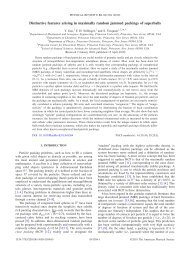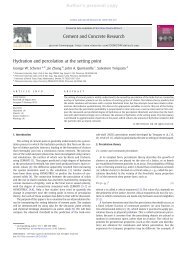Packing Nonspherical Particles - Princeton University
Packing Nonspherical Particles - Princeton University
Packing Nonspherical Particles - Princeton University
You also want an ePaper? Increase the reach of your titles
YUMPU automatically turns print PDFs into web optimized ePapers that Google loves.
<strong>Packing</strong> <strong>Nonspherical</strong> <strong>Particles</strong>: All Shapes Are Not Created Equal<br />
Salvatore Torquato<br />
Department of Chemistry,<br />
Department of Physics,<br />
<strong>Princeton</strong> Center for Theoretical Science,<br />
and Program in Applied & Computational Mathematics<br />
<strong>Princeton</strong> <strong>University</strong><br />
http://cherrypit.princeton.edu<br />
. – p. 1/28
Geometric Structure Approach to Jammed Particle <strong>Packing</strong>s<br />
Torquato & Stillinger, Rev. Mod. Phys. (2010)<br />
. – p. 2/28
Geometric Structure Approach to Jammed Particle <strong>Packing</strong>s<br />
Torquato & Stillinger, Rev. Mod. Phys. (2010)<br />
Order Maps for Jammed Sphere <strong>Packing</strong>s<br />
. – p. 2/28
Geometric Structure Approach to Jammed Particle <strong>Packing</strong>s<br />
Torquato & Stillinger, Rev. Mod. Phys. (2010)<br />
Order Maps for Jammed Sphere <strong>Packing</strong>s<br />
Optimal Strictly Jammed <strong>Packing</strong>s<br />
A: Z = 7 MRJ: Z = 6 (isostatic) B: Z = 12<br />
• MRJ packings are hyperuniform with quasi-long-range pair correlations with decay 1/r 4 .<br />
. – p. 2/28
3D Hard Spheres in Equilibrium<br />
Torquato & Stillinger, Rev. Mod. Phys. (2010)<br />
. – p. 3/28
Dense <strong>Packing</strong>s of <strong>Nonspherical</strong> <strong>Particles</strong> in R 3<br />
Granular Media Bucky Ball: C60 Truncated Icosahedron<br />
. – p. 4/28
Dense <strong>Packing</strong>s of <strong>Nonspherical</strong> <strong>Particles</strong> in R 3<br />
Granular Media Bucky Ball: C60 Truncated Icosahedron<br />
Ellipsoids: Donev et al., Science (2004)<br />
. – p. 4/28
Definitions<br />
A collection of nonoverlapping congruent particles in d-dimensional<br />
Euclidean space R d is called a packing P .<br />
The density φ(P) of a packing is the fraction of space R d covered by the<br />
particles.<br />
Lattice packing ≡ a packing in which particle centroids are specified by<br />
integer linear combinations of basis (linearly independent) vectors. The space<br />
R d can be geometrically divided into identical regions F called fundamental<br />
cells, each of which contains just one particle centroid. For example, in R 2 :<br />
Thus, if each particle has volume v1:<br />
φ = v1<br />
Vol(F) .<br />
. – p. 5/28
Definitions<br />
A periodic packing is obtained by placing a fixed nonoverlapping<br />
configuration of N particles in each fundamental cell.<br />
Thus, the density is<br />
φ = Nv1<br />
Vol(F) .<br />
. – p. 6/28
Definitions<br />
A periodic packing is obtained by placing a fixed nonoverlapping<br />
configuration of N particles in each fundamental cell.<br />
Thus, the density is<br />
φ = Nv1<br />
Vol(F) .<br />
A particle is centrally symmetric if it has a center C that bisects every chord<br />
through C connecting any two boundary points.<br />
centrally symmetric centrally symmetric non-centrally symmetric<br />
2 equivalent ⊥ axes 2 inequivalent ⊥ axes<br />
. – p. 6/28
Hyperuniformity for General Point Patterns<br />
Torquato and Stillinger, PRE (2003)<br />
R Ω<br />
R<br />
Ω<br />
Denote by σ 2 (R) ≡ 〈N 2 (R)〉 − 〈N(R)〉 2 the number variance.<br />
For a Poisson point pattern and many correlated point patterns, σ 2 (R) ∼ R d .<br />
We call point patterns whose variance grows more slowly than R d hyperuniform<br />
(infinite-wavelength fluctuation vanish). This implies that structure factor S(k) → 0 for k → 0.<br />
The hyperuniformity concept enables us to classify crystals and quasicrystals together with<br />
special disordered point processes.<br />
All crystals and quasicrystals are hyperuniform such that σ 2 (R) ∼ R d−1 – number variance<br />
grows like window surface area.<br />
Many different MRJ particle packings are hyperuniform with S(k) ∼ k for k → 0.<br />
Donev, Stillinger & Torquato, 2005; Berthier et al., 2011;<br />
Zachary, Jiao & Torquato, 2011; Kurita and Weeks, 2011.<br />
. – p. 7/28
Outline<br />
Organizing principles for maximally dense packings of<br />
nonspherical particles.<br />
Organizing principles for MRJ packings of nonspherical<br />
particles (e.g., isostatic or not; hyperuniformity, etc.).<br />
Tunability capability via particle shape to design novel crystal,<br />
liquid and glassy states.<br />
. – p. 8/28
<strong>Packing</strong>s of the Platonic and Archimedean Solids<br />
Difficulty in obtaining maximally dense packings of polyhedra: complex<br />
rotational degrees of freedom and non-smooth shapes.<br />
. – p. 9/28
<strong>Packing</strong>s of the Platonic and Archimedean Solids<br />
Difficulty in obtaining maximally dense packings of polyhedra: complex<br />
rotational degrees of freedom and non-smooth shapes.<br />
Torquato & Jiao, Nature (2009); PRE (2009); PRE (2010)<br />
Platonic Solids<br />
Archimedean Solids<br />
. – p. 9/28
Adaptive Shrinking Cell<br />
Optimization scheme that explores many-particle configurational space<br />
and the space of lattices to obtain a local or global maximal density.<br />
(a) (b) (c)<br />
ASC scheme can be solved using a variety of techniques, depending on<br />
the particle shape, including MC and linear-programming methods. For<br />
spheres, the latter is very efficient [Torquato and Jiao, PRE (2010)].<br />
. – p. 10/28
Kepler-Like Conjecture for a Class of Polyhedra<br />
Face-to-face contacts allow higher packing density.<br />
Central symmetry enables maximal face-to-face contacts when<br />
particles are aligned – consistent with the optimal lattice packing.<br />
For any packing of nonspherical particles of volume vparticle:<br />
upper bound<br />
φmax ≤ φmax = min<br />
vparticle<br />
vsphere<br />
<br />
π<br />
√ ,1<br />
18<br />
where vsphere is the volume of the largest sphere that can be inscribed<br />
in the nonspherical particle.<br />
,<br />
. – p. 11/28
Kepler-Like Conjecture for a Class of Polyhedra<br />
Face-to-face contacts allow higher packing density.<br />
Central symmetry enables maximal face-to-face contacts when<br />
particles are aligned – consistent with the optimal lattice packing.<br />
For any packing of nonspherical particles of volume vparticle:<br />
upper bound<br />
φmax ≤ φmax = min<br />
vparticle<br />
vsphere<br />
<br />
π<br />
√ ,1<br />
18<br />
where vsphere is the volume of the largest sphere that can be inscribed<br />
in the nonspherical particle.<br />
These considerations lead to the following conjecture:<br />
The densest packings of the centrally symmetric Platonic and Archimedean<br />
solids are given by their corresponding optimal lattice packings.<br />
S. Torquato and Y. Jiao, Nature 2009; PRE 2009; PRE<br />
,<br />
. – p. 11/28
Dense <strong>Packing</strong>s of Icosahedra, Dodecahedra & Octahedra<br />
ASC scheme with many particles per cell yield densest lattice packings for<br />
centrally Platonic solids!<br />
Icosahedra Dodecahedra Octahedra<br />
φ = 0.836 φ = 0.904 φ = 0.947<br />
Later showed octahedron packing leads to uncountably infinite number of<br />
tessellations by octahedra and tetrahedra (Conway, Jiao & Torquato 2010).<br />
. – p. 12/28
Superballs<br />
A d-dimensional superball is a centrally symmetric body in R d occupying<br />
|x1| 2p + |x2| 2p + · · · + |xn| 2p ≤ 1 (p: deformation parameter)<br />
Superdisks<br />
Superballs<br />
Densest packings are lattices and behave quite differently from<br />
ellipsoid packings! Jiao, Stillinger & Torquato, PRL (2008); PRE (2009) . – p. 13/28
φ<br />
1<br />
0.9<br />
0.8<br />
0.76<br />
0.7595<br />
1.15 1.1525<br />
Maximally Dense Superball <strong>Packing</strong>s<br />
Jiao, Stillinger & Torquato, PRE (2009)<br />
O 1 -Lattice <strong>Packing</strong><br />
O 0 -Lattice <strong>Packing</strong><br />
C 0 Lattice-<strong>Packing</strong><br />
C 1 -Lattice <strong>Packing</strong><br />
0.7<br />
0.5 1 1.5 2 2.5 3 3.5 4 4.5 5<br />
p<br />
Maximally dense packings are certain families of lattices for p ≥ 1/2.<br />
Densest ellipsoid packings are non-lattices.<br />
Maximal density is nonanalytic at the “sphere” point (p = 1) (in<br />
contrast to ellipsoids) and increases dramatically as p moves away<br />
from unity.<br />
Rich phase behavior depending on p (Batten, Stillinger & Torquato<br />
2010; Ni et al. 2012).<br />
. – p. 14/28
Conjecture 2:<br />
Another Organizing Principle<br />
The optimal packing of any convex, congruent polyhedron without<br />
central symmetry is generally not a (Bravais) lattice packing.<br />
S. Torquato and Y. Jiao, Nature 2009; PRE 2009; PRE 2010.<br />
. – p. 15/28
Tetrahedron <strong>Packing</strong>s<br />
Regular tetrahedra cannot tile space.<br />
Densest lattice packing (Hoylman, 1970): φ = 18/49 = 0.3673 . . .<br />
Densest packing must be a non-lattice (Conway & Torquato, 2006). Constructed a 20-particle<br />
packing with φ ≈ 0.72<br />
MRJ isostatic packings of tetrahedral dice (Chaikin et al., 2007): φ ≈ 0.74<br />
Many subsequent studies improved on this density with complicated fundamental cells (Chen,<br />
2008; Torquato & Jiao, 2009; Haji-Akbari et. al. 2009).<br />
Recently, 3 different groups (Kallus et al. 2010; Torquato and Jiao 2010; and Chen et al. 2010) have<br />
found 4-particle packings with φ ≈ 0.86.<br />
. – p. 16/28
<strong>Packing</strong>s of Truncated Tetrahedra<br />
The Archimedean truncated tetrahedron cannot tile space.<br />
Densest lattice packing (Betke & Henk, 2000): φ = 207/304 = 0.680 . . .<br />
A dense non-lattice packing with a two-particle (dimer) basis was constructed by Conway and<br />
Torquato (2006) with φ = 23/24 = 0.958 . . ..<br />
Derived analytically packing that nearly fills space: φ = 207/208 = 0.995 . . .. Can be obtained<br />
by continuously deforming the Conway-Torquato packing. It has small tetrahedral holes and is a<br />
new tessellation of space with truncated tetrahedra and tetrahedra (Jiao & Torquato, 2011).<br />
Two-stage melting process: optimal packing is stable at high densities and the Conway-Torquato<br />
packing is stable at lower densities upon melting.<br />
. – p. 17/28
Conjecture 3:<br />
Another Organizing Principle<br />
Optimal packings of congruent, centrally symmetric particles that do<br />
not possesses three equivalent principle axes generally cannot be a<br />
Bravais lattice.<br />
S. Torquato and Y. Jiao, Nature 2009; PRE 2009; PRE 2010.<br />
. – p. 18/28
Maximally Dense Ellipsoidal <strong>Packing</strong>s<br />
Densest known packings are non-Bravais lattices.<br />
Donev, Stillinger, Chaikin and Torquato, PRL, 2004.<br />
With relatively small asphericity, can achieve φ = 0.7707.<br />
. – p. 19/28
Densest Known <strong>Packing</strong>s of Some Convex <strong>Particles</strong><br />
Table 1: Densest Known <strong>Packing</strong>s of Some Convex <strong>Particles</strong><br />
Particle <strong>Packing</strong> Density Central Symmetry Equivalent Axis Structure<br />
Sphere 0.740 Y Y Bravais Lattice<br />
Ellipsoid 0.740 - 0.770 Y N Periodic, 2-particle basis<br />
Superball 0.740 - 1 Y Y Bravais Lattice<br />
Tetrahedron 0.856 N Y Periodic, 4-particle basis<br />
Icosahedron 0.836 Y Y Bravais Lattice<br />
Dodecahedron 0.904 Y Y Bravais Lattice<br />
Octahedron 0.945 Y Y Bravais Lattice<br />
Trun. Tetrah. 0.995 N Y Periodic, 2-particle basis<br />
Cube 1 Y Y Bravais Lattice<br />
. – p. 20/28
Generalizations of the Organizing Principles to Concave <strong>Particles</strong><br />
Generalization of Conjecture 1:<br />
Torquato and Jiao, PRE, 2010.<br />
Dense packings of centrally symmetric concave, congruent polyhedra with three equivalent axes are<br />
given by their corresponding densest lattice packings, providing a tight density lower bound that may be<br />
optimal.<br />
Generalization of Conjecture 2:<br />
Dense packings of concave, congruent polyhedra without central symmetry are composed of centrally<br />
symmetric compound units of the polyhedra with the inversion-symmetric points lying on the densest<br />
lattice associated with the compound units, providing a tight density lower bound that may be optimal.<br />
(a) (b)<br />
Figure 1: (a) Centrally symmetric concave octapod and the associated optimal Bravais-lattice<br />
packing. (b) Concave tetrapods without center symmetry forming a centrally symmetric dimer, which then<br />
pack on a Bravais lattice [de Graaf et al, Phys. Rev. Lett. 107, 155501 (2011)].<br />
. – p. 21/28
<strong>Nonspherical</strong> <strong>Particles</strong> and Rotational Degrees of Freedom<br />
Isostatic (Isoconstrained): Total number of contacts (constraints)<br />
equals total number of degrees of freedom. Conventionally, thought to<br />
be associated minimal number of constraints for rigidity and random<br />
(generic) packings.<br />
Z = 2f<br />
Z: average no. of contacts/particle; f: degrees of freedom/particle<br />
f = 2 for disks, f = 3 for ellipses, f = 3 for spheres, f = 5 for<br />
spheroids, and f = 6 for general ellipsoids.<br />
Hypostatic:<br />
Z ≤ 2f<br />
Conventionally thought to be unstable.<br />
Hyperstatic:<br />
True of ordered packings.<br />
Z ≥ 2f<br />
. – p. 22/28
φ J<br />
0.74<br />
0.72<br />
0.7<br />
0.68<br />
0.66<br />
0.64<br />
Z<br />
12<br />
10<br />
8<br />
6<br />
MRJ Ellipsoidal <strong>Packing</strong>s<br />
1<br />
α<br />
2 3<br />
β=1 (oblate)<br />
β=1/4<br />
β=1/2<br />
β=3/4<br />
β=0 (prolate)<br />
1 1.5 2 2.5 3<br />
Aspect ratio α<br />
There is a competition between translational & rotational jamming.<br />
Rotational degrees of freedom lead to improved density (over spheres) and allows for correlated<br />
contacts, which leads to MRJ hypostatic jammed packings.<br />
Donev, Connelly, Stillinger & Torquato, PRE (2007)<br />
. – p. 23/28
φ<br />
0.78<br />
0.75<br />
0.72<br />
0.69<br />
0.66<br />
0.63<br />
MRJ Superball <strong>Packing</strong>s<br />
Jiao, Stillinger & Torquato (2009)<br />
1 1.5 2 2.5 3<br />
p<br />
Z<br />
8<br />
7.5<br />
7<br />
6.5<br />
1 1.5 2 2.5 3<br />
p<br />
<strong>Packing</strong> density increases monotonically as p deviates from 1.<br />
Disordered superball packings are always hypostatic and do not come<br />
close to the isostatic contact number as asphericity increases!<br />
Isostatic disordered superball packings are difficult to construct; they<br />
require Z = 12, which is associated with crystal packings.<br />
. – p. 24/28
MRJ <strong>Packing</strong>s of Nontiling Platonic Solids<br />
Jiao & Torquato, PRE (2011)<br />
Hyperuniform with quasi-long-rang (QLR) pair correlations (1/r 4 ) and isostatic.<br />
S(k)<br />
4<br />
3<br />
2<br />
1<br />
tetrahedra<br />
icosahedra<br />
dodecahedra<br />
octahedra<br />
0.1<br />
0.05<br />
0<br />
0 0.2 0.4<br />
0<br />
0 5 10<br />
kσ/2π<br />
(a)<br />
Figure 2: (a) Structure factor S(k) of the MRJ packings of the nontiling Platonic solids. The inset<br />
shows that S(k) is linear in k for small k values. (b) Local contacting configurations: from left to right,<br />
tetrahedra, icosahedra, dodecahedra, and octahedra.<br />
(b)<br />
. – p. 25/28
MRJ <strong>Packing</strong>s of Nontiling Platonic Solids<br />
Table 2: Characteristics of MRJ packings of hard particles with different shapes.<br />
Particle Shape Isostatic Hyperuniform QLR MRJ <strong>Packing</strong> Fraction<br />
Sphere Yes Yes 0.642<br />
Ellipsoid No (hypostatic) Yes 0.642 − 0.720<br />
Superball No (hypostatic) Yes 0.642 − 0.674<br />
Superellipsoid No (hypostatic) Yes 0.642 − 0.758<br />
Octahedron Yes Yes 0.697<br />
Icosahedron Yes Yes 0.707<br />
Dodecahedron Yes Yes 0.716<br />
Tetrahedron Yes Yes 0.763<br />
. – p. 26/28
Generalization of Hyperuniformity to Polydisperse Systems<br />
Structure factor of the MRJ packing of polydisperse particles does not vanish at k = 0 (Kurita &<br />
Weeks, PRE 2010; Berthier et al., PRL 2011; Zachary, Jiao, & Torquato, PRL 2011).<br />
Introduced a more general notion of hyperuniformity involving local-volume-fraction fluctuations<br />
and associated spectral function ˜χ(k) for general two-phase media (packings or not) (Zachary &<br />
Torquato, J. Stat. Mech. 2009).<br />
We have shown that MRJ packings of hard-particles are hyperuniform with QLR correlations (i.e.,<br />
˜χ(k) → 0 as k → 0), regardless of the particle shapes or relative sizes (Zachary, Jiao &<br />
Torquato, PRL 2011; PRE 2011).<br />
. – p. 27/28
CONCLUSIONS<br />
Non-spherical particles are not created equal! Changing the shape of a<br />
particle can dramatically alter its packing attributes.<br />
We now have some organizing principles for both maximally dense and MRJ<br />
packings of nonspherical particles.<br />
Tunability capability via particle shape could be used to tailor many-particle<br />
systems (e.g., colloids and granular media) to have designed crystal, liquid<br />
and glassy states.<br />
Collaborators<br />
Robert Batten, <strong>Princeton</strong><br />
Robert Connelly, Cornell<br />
John Conway, <strong>Princeton</strong><br />
Paul Chaikin, NYU<br />
Aleks Donev, <strong>Princeton</strong>/Courant<br />
Yang Jiao, <strong>Princeton</strong><br />
Frank Stillinger, <strong>Princeton</strong><br />
Chase Zachary, <strong>Princeton</strong><br />
Acknowledgments: NYU/<strong>Princeton</strong> NSF MRSEC<br />
. – p. 28/28


